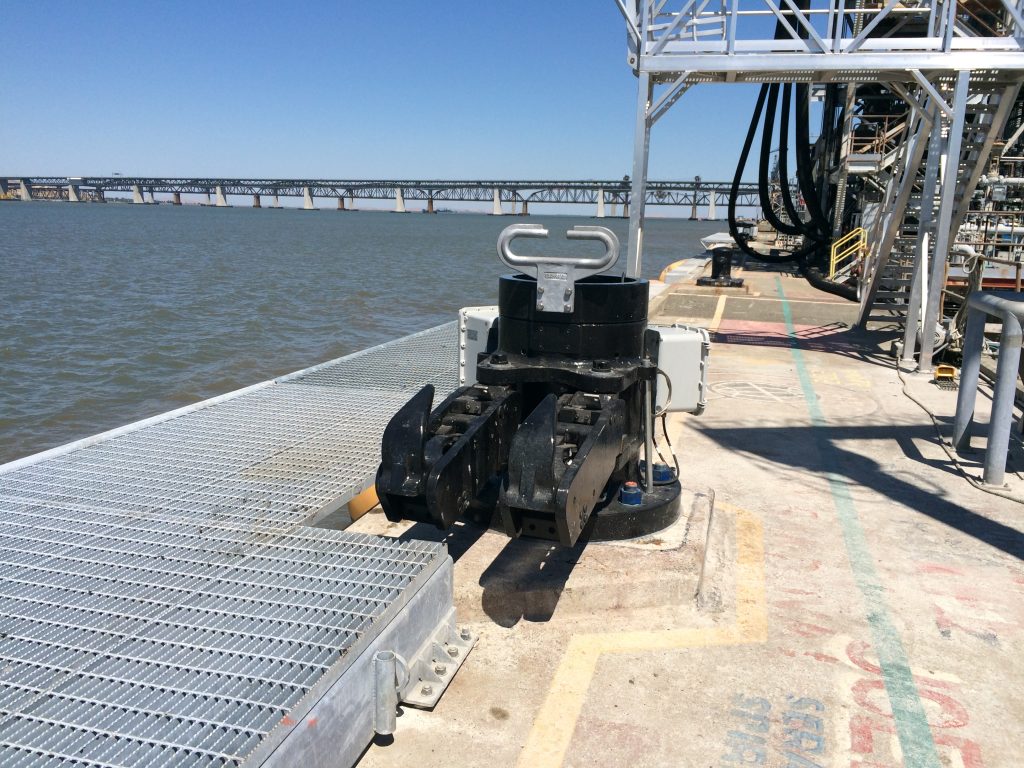Challenges and Considerations in Selection, Anchorage Design, and Installation of Quick-Release Mooring Hooks on Existing Structures

Quick release mooring hooks have become increasingly popular for use in design of new mooring systems, especially for larger vessels. Hooks offer several operational and safety benefits over the standard bollards or cleats. Such benefits include the abilities to release mooring lines without de-tensioning the lines, release mooring lines remotely from an operator’s shack in possible emergency situations, and monitoring of tension in the mooring lines while a vessel is at berth. In addition, mooring hooks are increasingly being required for new installations by local rules or regulations.
Selection, design, and installation of quick release mooring hooks follow a relatively straight forward path when applied in design of new structures. Several institutions and authorities offer codes or guidelines to aid in this process, such as British Standards in the UK, the Marine Oil Terminals Engineering and Maintenance Standards (MOTEMS) in California, or the soon to be released document from PIANC Working Group MarCom 153 “Recommendations for the Design of Marine Oil Terminals”.
Quick release mooring hook installations in new design will be in a best practice scenario adhere to a hierarchy of failure modes that attempt to maximize safety and minimize economic impact if the mooring system is overloaded. PIANC Working Group MarCom 153 has identified that the successive modes of failure should be as follows: winch brake tending, mooring line failure, mooring hook failure, mooring structure failure. While the concept is simple for new design, ensuring that the progression of failure adheres to this hierarchy can be difficult when any changes are made to an existing mooring system. These changes can occur at different levels, including change in mooring line strengths or types that are seen at vessels calling at a terminal, upgrades of mooring hardware at a terminal due to regulatory requirements, or upgrade of mooring hardware due to changes of service at a terminal. The question will then arise as to how a possible break in the hierarchy of failure modes can best be handled and at what point in the chain the break should be implemented. In addition, existing marine terminals may have mooring systems and structures that were not designed to these standards, making possible upgrades of the mooring system even more challenging.
This paper will present three case studies that will focus on the challenges and solutions selected for mooring hook installation on existing structures in California. All three cases presented different challenges based on the reason for the upgrades, ranging from voluntary upgrades to installations required by regulatory requirements, the strength of the mooring hook support structures, environmental conditions at the sites, and the size of vessels expected to be calling at the terminals.
The challenges faced started with the selection of appropriate mooring hooks for the installation to satisfy the requirements presented by local regulations. The challenges faced included selection of the number of mooring hooks, the appropriate Safe Working Load (SWL) for the individual hooks and the mooring hook assemblies, as well as the design and selection of the anchorage system. Further challenges faced included installation of mooring hooks while keeping the terminal open for traffic, both in terms of the order of installation of the hooks as well as methodologies to speed up the installation. Two of the sites were required to install tension monitoring of the mooring hooks. Complications arose when selecting appropriate limits for the mooring line tension monitoring system while simultaneously balancing safe tension limits with ease of operations for the terminal.
In addition, data will be presented from the ongoing monitoring of mooring line tensions after installation of the mooring hooks. The recorded values provide valuable insight into actual mooring line tensions. This paper will show how those values compare to design values as well as tension values obtained from mooring analyses. Cases that exhibit high line tension values will be studied in more detail, including data such as vessel loading condition, wind, and current data.
Publisher
PIANC 34th World Congress